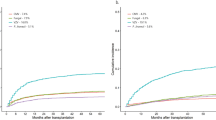Abstract
Although adding rituximab to standard cyclophosphamide, doxorubicin, vincristine, and prednisone (CHOP) chemotherapy is an efficacious and well-tolerated regimen in elderly patients with diffuse large B cell lymphoma (DLBCL), it may increase susceptibility to opportunistic infections, and such cases have been reported. Our study was to identify the risk factors for fungal infection in a retrospective case-control matched study of 34 elderly DLBCL patients treated with rituximab plus CHOP (R-CHOP) and 35 control patients treated with the standard CHOP regimen at the Taipei Veterans General Hospital, Taiwan. The rate of overall infection was similar in both groups. However, subgroup analysis found that the fungal infection rate was significantly different, 41.7 and 17.1%, in the R-CHOP and CHOP groups, respectively, (P = 0.03). Univariate analysis identified the rituximab plus CHOP chemotherapy regimen (P = 0.03), age older than 80 years (P = 0.04), and bone marrow involvement (P = 0.04) as risk factors for development of fungal infection, whereas, multivariate regression analysis identified only rituximab plus CHOP and old age. Adding rituximab to the standard CHOP regimen in elderly DLBCL patients might increase the incidence of fungal infection especially in those older than 80 years old.
Similar content being viewed by others
References
Bai LY, Yang MH, Chiou TJ, Liu JH, Yen CC, Wang WS (2003) Non-Hodgkin lymphoma in elderly patients: experience at Taipei Veterans General Hospital. Cancer 98:1188–1195
Gomez H, Hidalgo M, Casanova L, Colomer R, Pen DL, Otero J (1998) Risk factors for treatment-related death in elderly patients with aggressive non-Hodgkin’s lymphoma: results of a multivariate analysis. J Clin Oncol 16:2065–2069
Peters FP, Lalisang RI, Fickers MM, Erdkamp FL, Wils JA, Houben SG (2001) Treatment of elderly patients with intermediate- and high-grade non-Hodgkin’s lymphoma: a retrospective population-based study. Ann Hematol 80:155–159
Coiffier B, Lepage E, Briere J, Herbrecht R, Tilly H, Bouabdallah R (2002) CHOP chemotherapy plus rituximab compared with CHOP alone in elderly patients with diffuse large-B-cell lymphoma. N Engl J Med 346:235–242
Italiano A, Jardin F, Peyrade F, Saudes L, Tilly H, Thyss A (2005) Adapted CHOP plus rituximab in non-Hodgkin’s lymphoma in patients over 80 years old. Haematologica 90:1281–1283
Cheson BD, Horning SJ, Coiffier B, Shipp MA, Fisher RI, Connors JM (1999) Report of an international workshop to standardize response criteria for non-Hodgkin’s lymphomas. NCI Sponsored International Working Group. J Clin Oncol 17:1244
Guidelines for the use of antimicrobial agents in patients with febrile neutropenia in Taiwan (2005) J Microbiol Immunol Infect 38:455–457
Bone RC (1992) Toward an epidemiology and natural history of SIRS (systemic inflammatory response syndrome). JAMA 268:3452–3455
Cheng MF, Yang YL, Yao TJ, Lin CY, Liu JS, Tang RB (2005) Risk factors for fatal candidemia caused by Candida albicans and non-albicans Candida species. BMC Infect Dis 5:22
Karabinis A, Hill C, Leclercq B, Tancrede C, Baume D, Andremont A (1988) Risk factors for candidemia in cancer patients: a case-control study. J Clin Microbiol 26:429–432
Ribeiro P, Sousa AB, Nunes O, Aveiro F, Fernandes JP, Gouveia J (1997) Candidemia in acute leukemia patients. Support Care Cancer 5:249–251
Jantunen E, Salonen J, Juvonen E, Koivunen E, Siitonen T, Lehtinen T (2004) Invasive fungal infections in autologous stem cell transplant recipients: a nation-wide study of 1188 transplanted patients. Eur J Haematol 73:174–178
Safdar A, Singhal S, Mehta J (2004) Clinical significance of non-Candida fungal blood isolation in patients undergoing high-risk allogeneic hematopoietic stem cell transplantation (1993–2001) Cancer 100:2456–2461
Crameri R, Blaser K (2002) Allergy and immunity to fungal infections and colonization. Eur Respir J 19:151–157
Scheinfeld N (2005) Infections in the elderly. Dermatol Online J 11:8
Fridkin SK, Jarvis WR (1996) Epidemiology of nosocomial fungal infections. Clin Microbiol Rev 9:499–511
Guven GS, Uzun O, Cakir B, Akova M, Unal S (2005) Infectious complications in patients with hematological malignancies consulted by the Infectious Diseases team: a retrospective cohort study (1997–2001). Support Care Cancer 14(1):52–55
Cornely OA, Ullmann AJ, Karthaus M (2004) [Opportunistic infections after treatment with monoclonal antibodies]. Wien Med Wochenschr 154:209–217
Maloney DG, Grillo-Lopez AJ, White CA, Bodkin D, Schilder RJ, Neidhart JA (1997) IDEC-C2B8 (Rituximab) anti-CD20 monoclonal antibody therapy in patients with relapsed low-grade non-Hodgkin’s lymphoma. Blood 90:2188–2195
Buchanan KL, Murphy JW (1993) Characterization of cellular infiltrates and cytokine production during the expression phase of the anticryptococcal delayed-type hypersensitivity response. Infect Immun 61:2854–2865
Murphy JW (1993) Cytokine profiles associated with induction of the anticryptococcal cell-mediated immune response. Infect Immun 61:4750–4759
Murphy JW, Hidore MR, Wong SC (1993) Direct interactions of human lymphocytes with the yeast-like organism, Cryptococcus neoformans. J Clin Invest 91:1553–1566
Cassone A, Conti S, De Bernardis F, Polonelli L (1997) Antibodies, killer toxins and antifungal immunoprotection: a lesson from nature? Immunol Today 18:164–169
Bishop JF, Schimpff SC, Diggs CH, Wiernik PH (1981) Infections during intensive chemotherapy for non-Hodgkin’s lymphoma. Ann Intern Med 95:549–555
Acknowledgments
We greatly thank the Taiwan Cancer Foundation and Taipei Veterans General Hospital for their grant support in this study.
Author information
Authors and Affiliations
Corresponding author
Rights and permissions
About this article
Cite this article
Lin, PC., Hsiao, LT., Poh, SB. et al. Higher fungal infection rate in elderly patients (more than 80 years old) suffering from diffuse large B cell lymphoma and treated with rituximab plus CHOP. Ann Hematol 86, 95–100 (2007). https://doi.org/10.1007/s00277-006-0191-4
Received:
Accepted:
Published:
Issue Date:
DOI: https://doi.org/10.1007/s00277-006-0191-4




